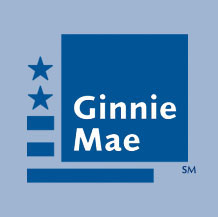Related Research Articles

The Government National Mortgage Association (GNMA), or Ginnie Mae, is a government-owned corporation of the United States Federal Government within the Department of Housing and Urban Development (HUD). It was founded in 1968 and works to expand affordable housing by guaranteeing housing loans (mortgages) thereby lowering financing costs such as interest rates for those loans. It does that through guaranteeing to investors the on-time payment of mortgage-backed securities (MBS) even if homeowners default on the underlying mortgages and the homes are foreclosed upon.
The Federal National Mortgage Association (FNMA), commonly known as Fannie Mae, is a United States government-sponsored enterprise (GSE) and, since 1968, a publicly traded company. Founded in 1938 during the Great Depression as part of the New Deal, the corporation's purpose is to expand the secondary mortgage market by securitizing mortgage loans in the form of mortgage-backed securities (MBS), allowing lenders to reinvest their assets into more lending and in effect increasing the number of lenders in the mortgage market by reducing the reliance on locally based savings and loan associations. Its brother organization is the Federal Home Loan Mortgage Corporation (FHLMC), better known as Freddie Mac. In 2022, Fannie Mae was ranked number 33 on the Fortune 500 rankings of the largest United States corporations by total revenue.

Franklin Delano Raines also known as Frank Raines is an American business executive. He is the former chairman and chief executive officer of the Federal National Mortgage Association, commonly known as Fannie Mae, who served as White House budget director under President Bill Clinton. His role leading Fannie Mae has come under scrutiny. He has been called one of the "25 People to Blame for the Financial Crisis" according to Time magazine.

The Federal Home Loan Mortgage Corporation (FHLMC), commonly known as Freddie Mac, is a publicly traded, government-sponsored enterprise (GSE), headquartered in Tysons, Virginia. The FHLMC was created in 1970 to expand the secondary market for mortgages in the US. Along with the Federal National Mortgage Association, Freddie Mac buys mortgages, pools them, and sells them as a mortgage-backed security (MBS) to private investors on the open market. This secondary mortgage market increases the supply of money available for mortgage lending and increases the money available for new home purchases. The name "Freddie Mac" is a variant of the FHLMC initialism of the company's full name that was adopted officially for ease of identification.

A mortgage-backed security (MBS) is a type of asset-backed security which is secured by a mortgage or collection of mortgages. The mortgages are aggregated and sold to a group of individuals that securitizes, or packages, the loans together into a security that investors can buy. Bonds securitizing mortgages are usually treated as a separate class, termed residential; another class is commercial, depending on whether the underlying asset is mortgages owned by borrowers or assets for commercial purposes ranging from office space to multi-dwelling buildings.
A government-sponsored enterprise (GSE) is a type of financial services corporation created by the United States Congress. Their intended function is to enhance the flow of credit to targeted sectors of the economy, to make those segments of the capital market more efficient and transparent, and to reduce the risk to investors and other suppliers of capital. The desired effect of the GSEs is to enhance the availability and reduce the cost of credit to the targeted borrowing sectors primarily by reducing the risk of capital losses to investors: agriculture, home finance and education. Well known GSEs are the Federal National Mortgage Association, known as Fannie Mae, and the Federal Home Loan Mortgage Corporation, or Freddie Mac.
In the United States, a conforming loan is a mortgage loan that both meets the underwriting guidelines of Fannie Mae and Freddie Mac and that does not exceed the conforming loan limit. The most well-known guideline is the size of the loan which, for 2022, was generally limited to $647,200 for one-unit single family homes in the continental US. Other guidelines include borrower's loan-to-value ratio, debt-to-income ratio, credit score and history, documentation requirements, etc.
In the United States, a jumbo mortgage is a mortgage loan that may have high credit quality, but is in an amount above conventional conforming loan limits. This standard is set by the two government-sponsored enterprises, Fannie Mae and Freddie Mac, and sets the limit on the maximum value of any individual mortgage they will purchase from a lender. Fannie Mae (FNMA) and Freddie Mac (FHLMC) are large agencies that purchase the bulk of U.S. residential mortgages from banks and other lenders, allowing them to free up liquidity to lend more mortgages. When FNMA and FHLMC limits don't cover the full loan amount, the loan is referred to as a "jumbo mortgage". Traditionally, the interest rates on jumbo mortgages are higher than for conforming mortgages, however with GSE fees increasing, Jumbo loans have recently seen lower interest rates than conforming loans.
In finance, subprime lending is the provision of loans to people in the United States who may have difficulty maintaining the repayment schedule. Historically, subprime borrowers were defined as having FICO scores below 600, although this threshold has varied over time.
The United States subprime mortgage crisis was a multinational financial crisis that occurred between 2007 and 2010 that contributed to the 2007–2008 global financial crisis. The crisis led to a severe economic recession, with millions of people losing their jobs and many businesses going bankrupt. The U.S. government intervened with a series of measures to stabilize the financial system, including the Troubled Asset Relief Program (TARP) and the American Recovery and Reinvestment Act (ARRA).
A Jumbo mortgage is classified in the United States as a residential mortgage or other home-equity secured loan in an amount greater than $650,000, although lenders differ on just what constitutes a super jumbo mortgage subject to their own internal investment criteria. Super Jumbo mortgages are made available to borrowers whose loan requirements exceed the guidelines commonly referred to as Jumbo loan limits, which apply to mortgage loan amounts in excess of the FNMA / FHLMC conforming loan limits of 417,000. Unlike Jumbo loan limits, the super jumbo mortgage category is not directly defined, controlled, or regulated by any of these aforementioned agencies. Instead, mortgage lenders internally and independently define their own parameters and criteria for what defines a Super Jumbo mortgage. The minimum loan amount for some lenders to classify a loan as Super Jumbo ranges from $500,000 to $1,500,000, with maximum super jumbo loan amounts generally running into the $10,000,000 to $20,000,000 range.
A non-conforming mortgage is a term in the United States for a residential mortgage that does not conform to the loan purchasing guidelines set by the Federal National Mortgage Association /Federal Home Loan Mortgage Corporation. Mortgages which are non-conforming because they have a dollar amount over the purchasing limit set by FNMA/FHLMC are often called "jumbo" mortgages. Mortgages which are non-conforming because they do not meet FNMA/FHLMC underwriting guidelines are sometimes mistakenly called "subprime" mortgages. Non-conforming loans must remain in a lender's portfolio, or be sold to other companies who purchase non-conforming loans, or be securitized, with the securities being sold to investors seeking non-conforming mortgage-backed securities. Consequently, a premium is paid by those obtaining non-conforming mortgages, generally .25 or .5 points more than the same loan would cost if it were conforming. The loan amount is adjusted every few years depending upon the average sales price of homes in the U.S.
Mortgage underwriting is the process a lender uses to determine if the risk of offering a mortgage loan to a particular borrower under certain parameters is acceptable. Most of the risks and terms that underwriters consider fall under the three C's of underwriting: credit, capacity and collateral.

Bonds securitizing mortgages are usually treated as a separate class, termed residential mortgage-backed security (RMBS). In that sense, making reference to the general package of financial agreements that typically represents cash yields that are paid to investors and that are supported by cash payments received from homeowners who pay interest and principal according to terms agreed to with their lenders; it is a funding instrument created by the "originator" or "sponsor" of the mortgage loan; without cross-collateralizing individual loans and mortgages, it is a funding instrument that pools the cash flow received from individuals and pays these cash receipts out with waterfall priorities that enable investors to become comfortable with the certainty of receipt of cash at any point in time.
The subprime mortgage crisis impact timeline lists dates relevant to the creation of a United States housing bubble and the 2005 housing bubble burst and the subprime mortgage crisis which developed during 2007 and 2008. It includes United States enactment of government laws and regulations, as well as public and private actions which affected the housing industry and related banking and investment activity. It also notes details of important incidents in the United States, such as bankruptcies and takeovers, and information and statistics about relevant trends. For more information on reverberations of this crisis throughout the global financial system see Financial crisis of 2007–2008.

Observers and analysts have attributed the reasons for the 2001–2006 housing bubble and its 2007–10 collapse in the United States to "everyone from home buyers to Wall Street, mortgage brokers to Alan Greenspan". Other factors that are named include "Mortgage underwriters, investment banks, rating agencies, and investors", "low mortgage interest rates, low short-term interest rates, relaxed standards for mortgage loans, and irrational exuberance" Politicians in both the Democratic and Republican political parties have been cited for "pushing to keep derivatives unregulated" and "with rare exceptions" giving Fannie Mae and Freddie Mac "unwavering support".

In September 2008 the Federal Housing Finance Agency (FHFA) announced that it would take over the Federal National Mortgage Association and the Federal Home Loan Mortgage Corporation. Both government-sponsored enterprises, which finance home mortgages in the United States by issuing bonds, had become illiquid as the market for those bonds collapsed in the subprime mortgage crisis. The FHFA established conservatorships in which each enterprise's management works under the FHFA's direction to reduce losses and to develop a new operating structure that will allow a return to self-management.
The U.S. subprime mortgage crisis was a set of events and conditions that led to a financial crisis and subsequent recession that began in 2007. It was characterized by a rise in subprime mortgage delinquencies and foreclosures, and the resulting decline of securities backed by said mortgages. Several major financial institutions collapsed in September 2008, with significant disruption in the flow of credit to businesses and consumers and the onset of a severe global recession.
Loan modification is the systematic alteration of mortgage loan agreements that help those having problems making the payments by reducing interest rates, monthly payments or principal balances. Lending institutions could make one or more of these changes to relieve financial pressure on borrowers to prevent the condition of foreclosure. Loan modifications have been practiced in the United States since the 1930s. During the Great Depression, loan modification programs took place at the state level in an effort to reduce levels of loan foreclosures.

The mortgage industry of the United States is a major financial sector. The federal government created several programs, or government sponsored entities, to foster mortgage lending, construction and encourage home ownership. These programs include the Government National Mortgage Association, the Federal National Mortgage Association and the Federal Home Loan Mortgage Corporation.
References
- ↑ Lemke, Lins and Picard, Mortgage-Backed Securities, Chapter 3 (Thomson West, 2013 ed.).
- ↑ Lemke, Lins and Picard, Mortgage-Backed Securities, Chapter 3 (Thomson West, 2013 ed.).
- ↑ Fabozzi Fj. (2005). The handbook of mortgage-backed securities, pp. 207-57. McGraw-Hill Professional.
- ↑ Alt-A Mortgages.
- ↑ Fabozzi FJ. (1999). Fixed Income Securities, p. 286.
- ↑ Lemke, Lins and Picard, Mortgage-Backed Securities, Chapter 3 (Thomson West, 2013 ed.).
- ↑ Investopedia. Alternative Documentation.
- ↑ Lemke, Lins and Picard, Mortgage-Backed Securities, Chapter 3 (Thomson West, 2013 ed.).